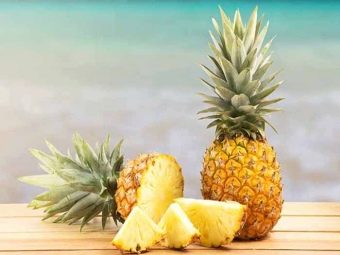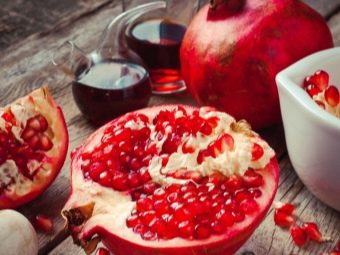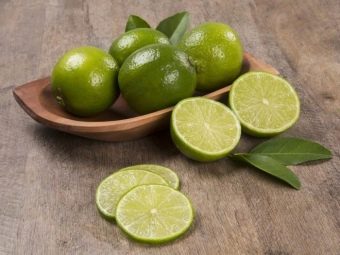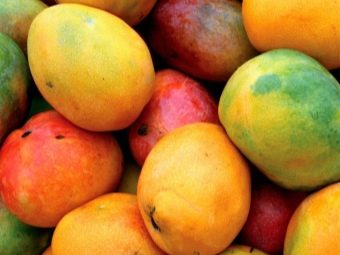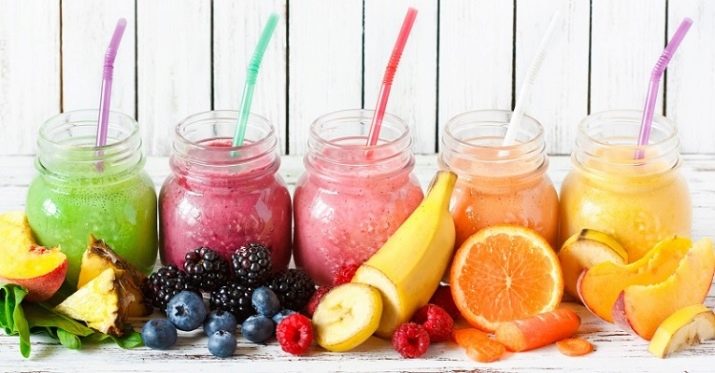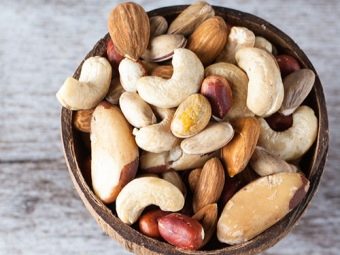Sugar content in fruits, its benefits and harm
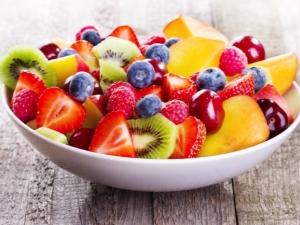
Many fruits, in addition to nutrients, contain varying amounts of sugar. There are fruits with high and low sweetness content.The use of these fruits can affect differently on the human body, so you should know the benefits and harm of the sugar content in various fruits.
Which fruits have the least sugar?
Sugar is a fast carbohydrate. Its glycemic index is 70 U. Such carbohydrates are rapidly absorbed into the blood, increasing the glucose content, and are ineffective for the organism as a whole. A large amount of carbohydrates with excessive consumption can do more harm than good. Therefore, their use should be made in accordance with the energy consumption, based on the needs in each case.
Sugar in fruits is in the form of fructose. It can also adversely affect the functioning of the heart muscle and blood vessels, increase weight and worsen diabetes. Anyone who is somehow susceptible to such diseases should regulate the consumption of sweet fruits.
There is the famous Sheldon list, in which fruits are subdivided into fruits with a low and high sugar index. The minimum amount of sugar found in acidic fruits. It can be:
- citrus fruits: lime, lemon, orange and grapefruit;
- pineapples;
- peaches and apricots;
- sour apples;
- cherry plum;
- cranberry.
Semi-sweet fruits include:
- white figs;
- plum;
- pear;
- mango;
- mandarins.
The "sweet" group includes:
- figs;
- bananas;
- grapes;
- dates;
- persimmon;
- lychee;
- passion fruit;
- cherries;
- dried fruits: prunes, dried apricots and raisins.
Nutritionists believe that a day is enough to eat two - three unsweetened fruit to compensate for the loss of sugar. Sweet fruits should not be consumed every day, but about twice a week. Fruits are rich in fiber, so you should give preference to them, rather than juices and other juice-containing products.
To find out the specific amount of sugar per 100 g of one or another fruit, we turn to the list-table:
- Litchi - 9.0 g;
- passion fruit - 11.2 g;
- Mandarin - 10.57 g;
- Kumquat - 9.37 g;
- grapes - 16.6 g;
- pomegranate - 16.56 g;
- figs - 16 g;
- persimmon - 16.52 g;
- mango - 14.7 g;
- sweet cherry - 15 gr;
- banana - 12.24 g;
- Cherry - 11.3 g;
- apple - 10.59 g;
- plum - 10 grams;
- pear - 9.6 g;
- apricot - 9.23 g;
- peach - 8.38 g;
- Kiwi - 8.98 g;
- Quince - 8.7 g;
- Nectarine - 7.90 g;
- Clementine - 9 g;
- grapefruit - 5.88 g;
- cherry plum - 4,3 gr;
- Lime - 1.70 g;
- lemon - 2.4 g;
- avocado - 0.68 gr.
Fruits are also divided into four groups. Allocate fruits:
- low glycemic index - up to 4 g / 100 g;
- small - up to 8 gr / 100 gr;
- medium - up to 12 g / 100 g;
- high - from 12 grams and higher.
The most savory is avocado, which is often mistaken for a vegetable. And the most sugar - grapes. In addition to sugar, these fruits have a number of useful substances necessary for the human body. With their proper use, you can benefit. So, moderate use of avocado and lime improves the functioning of the brain's blood vessels and helps restore the immune system.
Also, do not forget about the calorie content, which is not directly related to the sugar content. Avocados, for example, contain little sugar, but a lot of fatty acids, due to which it has a high calorie content. Therefore, it is enough to eat half of this product every other day. People on a diet are advised to consume fruits with low and medium sugar content that are low in calories. Thanks to the necessary fibers, elements, minerals and vitamins, they improve metabolism, due to which fat is burned better, and decomposition products are removed.
Acceleration of metabolism increases vitality, strengthens the body's immune system, promotes cleansing and rejuvenation. Sugar can also negate the efforts to reduce weight and improve health. Its excess contributes to undesirable fermentation in the intestine, the development of pathogenic microflora, and also reduces the absorbability of nutrients.
Where is his lot?
A large amount of fruit sugar contains: pomegranate, grapes, figs, mango, litchi, bananas, apples and pineapple.
Grapes contain a record amount of sweetness. One brush of any of its varieties can fill the weekly need for the product. Experts advise eating grapes instead of desserts and sweet dishes. This fruit is also called “wine berry” because of its short shelf life. Therefore, if you do not have time to eat it fresh, it is recommended to process the product into wine and vinegar. Grapes contain phytonutrients that protect cells and tissues from cancers.
Another "wine berry" is a fig. It is of several types: white and black. White is less sweet, cannot be stored, and black is used for the production of dried fruit. The dried product is more nutritious and contains more sugar than its raw counterpart. Figs is valued for its quality to purify the blood and remove radionuclides, heavy metals and free radicals from the human body.
Ripe mango contains more sugar than unripe fruit. There is so much glucose in it that one fruit is able to completely fill the daily need of the organism. Vitamin A in combination with resinous substances and polyphenols has a positive effect on the circulatory system, restores vision.
Pomegranate is valued due to the presence in the composition of a beneficial substance - punikalagina, which is used to treat cancer and oncology. This is one of the most useful fruits. Lychee is rarely found on store shelves. This small exotic fruit has a sugary candy flavor. There are so many sugars in it that equals the contents of a soda jar. Lychee is rich in fiber, ascorbic and potassium. Useful for human vascular, lymphatic and bone systems.
The sugar content in bananas increases as they ripen. A ripe fruit contains 15 grams of sucrose. They are used to make smoothies and sugar-free smoothies. The soft texture of the banana makes it indispensable for diet and baby food. Apples are different in sugar content. There are sour, sour-sweet and sweet varieties. Invariably, this is the most popular fruit. It is used to make juices and other beverages. Malic acid itself is a good preservative, thanks to which apples can be stored for a long time.
Sweet pineapple needs no introduction. This fruit is a festive table decoration. They love to feast on adults and children. This fruit contains a beneficial enzyme, bromelain, therefore it is able to cure inflammatory processes, and also eliminates extra pounds.
Anyone can pick a fruit to taste. The main thing is to use wisely the diversity that nature has given us.
The benefits of "natural sweets"
Note that it’s not always and not everyone can eat a pound of fruit at a time, but it’s pretty easy to drink a cup of chocolate or cocoa, although these foods contain the same amount of sugar.
Fruit sugar - in fact, the same fructose. Most of the sweet fruit is made entirely of it. Sugar and fructose have the same chemical formula and compounds, while fructose is sweeter.
By energy value, they are the same: 4 Kcal per gram. In humans, sugars are broken down into glucose and sucrose (fructose) compounds.
Fruit sugar has a long absorption phase in the intestines, and this makes it possible to attribute it to slow sugars. In addition, it rather slightly increases the sugar content in the blood, and liver cells easily convert it into fats.
Fructose breaks down into fatty acids much faster than its counterpart. Therefore, it is able to increase the glycemic index in the body, which contributes to weight gain. One water molecule contains three fat molecules. And there is plenty of water in fruit.
Industrial sugar, a disaccharide, is similar in formula to natural sugar, but is far inferior in quality. Natural fruit sugar concentration is significantly inferior to the chemical "fellow". And the matter is not at all in the qualitative, but more in the quantitative composition of sugar.The body equally perceives sugars, maltose, dextrose, fruit sugar and other monosaccharides and substitutes, including dietary sweeteners.
In addition to sugars, fruits consist of water, fiber, nutrients and elements. Many contain antioxidants and resins that can protect the body from the negative effects of the environment and toxins. therefore Nutritionists advise to enter into your diet a variety of smoothies.
Fruits can be eaten at any time of the day or night. Contrary to the stereotype, they do not provoke insulin release into the blood - you just need to know the measure in everything.
Possible harm
Some nutritionists believe that fruit sugar is a dangerous product, more dangerous than usual. The thing is that it is past the stages of glycogen storage in the liver and muscles and is immediately converted into fatty acids. This is partly the case. But not everything is so tragic. Yes, it breaks down into glucose and fruit sugar, but it is absolutely identical to the usual process.
It is believed that insulin sends glucose from fruits directly into adipose tissue, while the usual sugar, splitting, enters the muscle tissue and liver marked "for the needs of the body."
This is a major bias. I dare say that the body doesn’t care what kind of glucose it has: fruit or sugar. The principle of action of enzymes is the same and functions in all directions: both for long-term storage and for timely use.
Gaining weight is not due to fat, but due to the water that forms the matrix - the basis for its tissues. "Wrong" fat is formed, for example, due to the uncontrolled consumption of sweet soda and fast food. Fruit has nothing to do with it.
Tips on drinking
Feel free to eat fruit, just follow the simple rules.
- Many people know that in one meal many fruits cannot be eaten. Yes, a lot and is not required. The daily rate ranges from 100 to 120 grams. Exactly so much the body needs to replenish the supply of nutrients and calories.
- You can also eat baked, fried and boiled fruits as a dessert, combining them with various spices and nuts. The benefits of such a snack will be obvious.
- Sweet and sour-sweet fruits can be combined with low-fat yogurt, kefir and other dairy products.
- Grinding the fruit pieces in a blender to get a delicious fruit smoothie with milk or cream. You can add cocktails with berries and syrups for every taste.
Summarizing, we can conclude that the sugar in fruit is as common as the usual beet, cane and other sugar. Its consumption may be beneficial or harmful. Harm can only be expected if fructose is consumed in unmeasured quantities. The exceptions are persons with product intolerance and allergies.
Therefore, the rational use of fruit is welcome. Be healthy!
About what fruits you can eat diabetic, and what not, see the next video.


